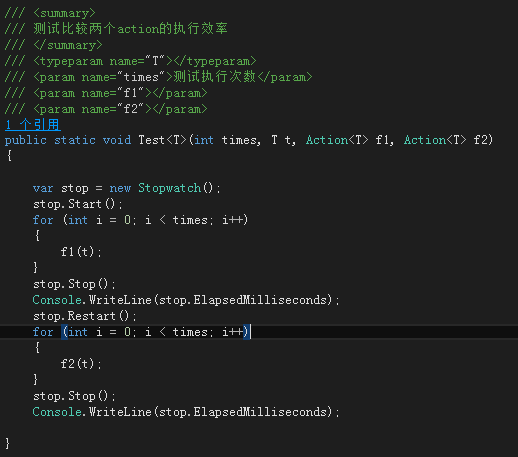即使用ADO.NET,也要轻量级实体映射,比Dapper和Ormlite均快
2015-06-12 18:37
459 查看
不管出于什么原因,有时候框架人员摒弃了NH或EF,而使用原生数据库访问对象。
为了优美的编程,用上我写的轻量级映射扩展方法吧
目的:将SqlDataReader自动转换成T类型
代码如下:
在项目中再也需要reader["fieldname"]这样的惹人厌的写法了
换言之,只需要这样写:
基本原理当然少不了反射,实体的属性可以用DataField特性标记在数据表中的字段名称,否则与属性同名,字段名称不区分大小写。
DataField特性是自己写的,只有一个Name属性。
是不是很方便,虽然重复造轮子了,但是即使用了原生数据库访问对象,又轻松了转换了实体,带来的方便性可以弥补一切。
记得点【推荐】
性能测试:
与OrmLite对比:

从图中看出,在测试1000次的时候,本文的扩展方法比OrmLite的方法快1263ms,测试多次效率均与该结果基本相符。
Test测试源码如下:

为了优美的编程,用上我写的轻量级映射扩展方法吧
目的:将SqlDataReader自动转换成T类型
代码如下:
/// <summary>
/// 提供将SqlDataReader转成T类型的扩展方法
/// </summary>
public static class SqlDataReaderEx
{
private static object _obj = new object();
/// <summary>
/// 属性反射信息缓存 key:类型的hashCode,value属性信息
/// </summary>
private static Dictionary<int, Dictionary<string, PropertyInfo>> propInfoCache = new Dictionary<int, Dictionary<string, PropertyInfo>>();
/// <summary>
/// 将SqlDataReader转成T类型
/// </summary>
/// <typeparam name="T"></typeparam>
/// <param name="reader"></param>
/// <returns></returns>
public static T To<T>(this SqlDataReader reader)
where T : new()
{
if (reader == null || reader.HasRows == false) return default(T);
var res = new T();
var propInfos = GetFieldnameFromCache<T>();
for (int i = 0; i < reader.FieldCount; i++)
{
var n = reader.GetName(i).ToLower();
if (propInfos.ContainsKey(n))
{
PropertyInfo prop = propInfos
;
var IsValueType = prop.PropertyType.IsValueType;
object defaultValue = null;//引用类型或可空值类型的默认值
if (IsValueType) {
if ((!prop.PropertyType.IsGenericType)
||(prop.PropertyType.IsGenericType&&!prop.PropertyType.GetGenericTypeDefinition().Equals(typeof(Nullable<>))))
{
defaultValue = 0;//非空值类型的默认值
}
}
var v = reader.GetValue(i);
prop.SetValue(res, (Convert.IsDBNull(v) ? defaultValue : v), null);
}
}
return res;
}
private static Dictionary<string, PropertyInfo> GetFieldnameFromCache<T>()
{
Dictionary<string, PropertyInfo> res = null;
var hashCode = typeof(T).GetHashCode();
var filedNames = GetFieldname<T>();
lock (_obj)
{
if (!propInfoCache.ContainsKey(hashCode))
{
propInfoCache.Add(hashCode, filedNames);
}
}
res = propInfoCache[hashCode];
return res;
}
/// <summary>
/// 获取一个类型的对应数据表的字段信息
/// </summary>
/// <typeparam name="T"></typeparam>
/// <returns></returns>
private static Dictionary<string, PropertyInfo> GetFieldname<T>()
{
var res = new Dictionary<string, PropertyInfo>();
var props = typeof(T).GetProperties();
foreach (PropertyInfo item in props)
{
res.Add(item.GetFieldName(), item);
}
return res;
}
/// <summary>
/// 将SqlDataReader转成List<T>类型
/// </summary>
/// <typeparam name="T"></typeparam>
/// <param name="reader"></param>
/// <returns></returns>
public static List<T> ToList<T>(this SqlDataReader reader)
where T : new()
{
if (reader == null || reader.HasRows == false) return null;
var res = new List<T>();
while (reader.Read())
{
res.Add(reader.To<T>());
}
return res;
}
/// <summary>
/// 获取该属性对应到数据表中的字段名称
/// </summary>
/// <param name="propInfo"></param>
/// <returns></returns>
public static string GetFieldName(this PropertyInfo propInfo)
{
var fieldname = propInfo.Name;
var attr = propInfo.GetCustomAttributes(false);
foreach (var a in attr)
{
if (a is DataFieldAttribute)
{
fieldname = (a as DataFieldAttribute).Name;
break;
}
}
return fieldname.ToLower();
}
}在项目中再也需要reader["fieldname"]这样的惹人厌的写法了
换言之,只需要这样写:
Model model=SqlDataReader.To<Model>();
基本原理当然少不了反射,实体的属性可以用DataField特性标记在数据表中的字段名称,否则与属性同名,字段名称不区分大小写。
DataField特性是自己写的,只有一个Name属性。
public class DataFieldAttribute : Attribute
{
public DataFieldAttribute()
{
}
public DataFieldAttribute(string name)
{
m_name = name;
}
private string m_name = null;
public string Name { get { return m_name; } set { m_name = value; } }
}是不是很方便,虽然重复造轮子了,但是即使用了原生数据库访问对象,又轻松了转换了实体,带来的方便性可以弥补一切。
记得点【推荐】
性能测试:
与OrmLite对比:

从图中看出,在测试1000次的时候,本文的扩展方法比OrmLite的方法快1263ms,测试多次效率均与该结果基本相符。
Test测试源码如下:

相关文章推荐
- Flex 4.6 在mxml中创建复杂Object
- 获取android项目相关信息
- Android_数据存储详解
- android 自定义progressbar 样式
- quick-cocos2dx在xcode下如何添加额外的文件夹
- quick-cocos2dx的windows版如何显示标题栏下方的菜单栏
- codeforces #549G Happy Line
- 如何使用Android MediaStore裁剪大图片
- 实现Activity的滑动返回效果
- IOS 需要学习的地方
- iBokan_ios80_自学系列_1(循环结构初练)
- 在Android studio 中配置高德地图api后显示地图遇到的问题
- IOS 调试lldb命令常用----po
- iOS scrollsToTop属性失效
- android实现程序开机自启动
- iOS 项目中用到的一些开源库和第三方组件
- Android内存泄露优化总结
- Objective_C学习笔记(2)类的使用学习概要
- iOS Code Signing 学习笔记
- Android开发者必须深入学习的10个应用开源项目
